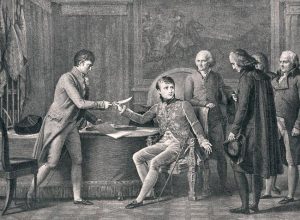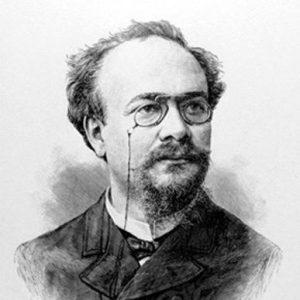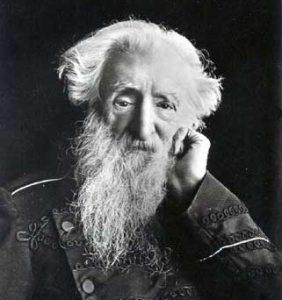The John Bost homes
“In the name of my master, I will welcome those who are rejected by all” – John Bost.
The foundation of the John Bost Homes was a moving and impressive event that was to become a long term project. This service organization is still very active today.
John Bost (1817-1881) was one of Pastor Amy Bost’s ten sons. After meeting Liszt, he had planned to become a pianist. But he followed in the footsteps of six of his brothers and decided to become a pastor. After his studies in Montauban, he was sent to the parish of La Force, a village in Dordogne. This assignment could have been the first of several others, but was to be his only one and was to know great developments.
Faced with insoluble problems within the framework of existing charities, including the placing of two girl orphans too young to be accepted by the county orphanage, he decided to host them at his vicarage and to take care of their education himself. It was the first home, founded in 1848, in which other orphaned girls were soon to be admitted. The organisation, bearing this “evangelical family’s” name, developed rapidly thanks to financial support asked for and received from the Churches of England and Scotland – to mention only a few. An executive board was soon appointed.
John Bost’s reputation as a host was such that he was soon asked to take in another girl orphan, but who was mentally handicapped. At first he refused because he lacked the means to take care of her and feared that she might trouble the harmony of the home. But as he was compelled to accept, he summoned up all his strength and managed to actively communicate with the child. This success resulted in other cases of similarly “half-witted girls”, as he called them, being brought to him. At this stage he opened the Bethesda home, near the vicarage, in 1854. Its aim was to take care of such handicapped people. In 1858, he was able to extend his programme to boy orphans and opened the Siloé Home. He was to open nine homes in all, while endlessly striving to raise funds in order to relieve such deep and varied suffering. He took care of the most destitute cases, rejected by society ; amongst them epileptics at a time when this illness, known as the “serious disorder”, was considered as the most threatening of all and the most troubling for the patient’s family. For them he opened the Eben Ezer home (“hitherto the Lord has saved me”).
The Home of Compassion was the last to be opened by John Bost, shortly before he died. Its aim was to provide better daily care for elderly patients whose handicap had become unbearable to themselves and to others. For all of these, a different quality of care and patience had to be elaborated.
Each home was built in a pleasant setting and within reach of the others. Each was provided with exceptional comfort for those days ; the most serious cases for example, had access to individual rooms. Moreover, educational activities were numerous and adapted to each patient ; some were taught gardening and others handicraft. And naturally Bible reading and hymn singing were the very foundations of this impressive community life.
Thanks to the untiring work of their founder, the John Bost homes were soon recognized of public interest (1877).
The John Bost Foundation in the twenty-first century
Since its origins the Foundation has taken care of the most severely handicapped. Although serving primarily, but not exclusively, members of the Protestant community, it remains open at a nation-wide level. It offers medium-long or long term stays and provides hospital care (the 1870 law on hospitals).
Nowadays, the Foundation welcomes children over six years of age, adults and seniors with all kinds of mental and learning disabilities, with the exception of :
- patients suffering from a contagious disease ;
- patients suffering from acute psychiatric disorders whose behaviour could endanger their own life or that of the others ;
- patients with a drug or alcohol addiction or with psychopathic problems.
The Foundation publishes a quarterly periodical, Notre Prochain (Our Neighbour).
Saint-Hippolyte du Fort Institution for the French Protestant deaf and dumb
The Saint-Hippolyte-du-Fort School (Gard) was founded in 1856. The decision to set up this home for the deaf in such a small village in the Protestant Cévennes is most significant : it was taken as a deliberately anti-Catholic measure. The Catholic Church had paid great attention to communication problems of deaf people : an example of this was the work carried out by Father de l’Epée (who had succeeded in taming the wolf child) and especially that of Father Sicard. Sign language had been recognized as a language of its own and as a means of communication among the deaf that was likely gave access to writing. Protestants were worried by Catholic attempts to convert the deaf who did not adhere to the Roman Catholic Church. As a result, the head and staff of the Saint-Hippolyte School decided to highlight their different approach : that of teaching the deaf to speak, even the most severely affected. To give a controversial nature to such a different approach could not really favour the cause they were serving ; but such a method did help the deaf to get out of their isolation. Moreover, some experiments had had encouraging results, especially one such experiment conducted in French in Lausanne, Switzerland. The necessary funding was raised to invite one of the teachers from this Swiss school. It is not certain as to what teaching method was adopted, nor as to whether the sign language was used as a preliminary to speech learning. It is likely that oral skills remained limited. Obviously the vocational training (such as gardening or bakery apprentice) offered by the school alongside the initial education requested more observational skills than oral ones. Despite its unproven efficiency, the school was soon recognized as being of public interest (1865) and the teaching of oral skills rapidly became widespread.
This method was soon adopted by the public system of free, compulsory and secular education. Several politicians that had worked on the Third Republic reforms were Protestant or of Protestant origins. But this was not their best contribution to these reforms as the demands of this method were the cause of school failure for many of these children. What happened next is well-known : deaf children were taken care of by schools supervised by the Ministry of public health which, instead of integrating them into society, stressed the heavy burden of their handicap.
The reforms of the Third Republic depriving it of the sphere of activity for which it had been created, the Saint-Hippolyte-du-Fort School began to take care of autistic children as well as of children in great psychological distress.
Various service organisations
A kind of interior missionary activity was organised to ensure an active Protestant presence in areas where the Catholic Church was very active and did not hesitate to convert those who resorted to their help. Numerous hostels, nursing homes, health care centres were created on Catholic ground, including the seaside, winter and spa resorts that grew in great number during the second half of the nineteenth century.
Such was the case of the Muette Home which opened in 1854 thanks to the bequests of Mrs. Thuret and Mr. Jameson in order to take care of elderly people with very low income. In Neuilly, the Cité des Fleurs opened after a cholera epidemic in 1866. The Nanterre Home opened in 1862 to care for the elderly and orphans after the 1870 war and was recognized of public interest in 1880 ; it is still active today (now under the authority of the governmental social and hygiene services).
Recently rebuilt, la Muette (43, Sergent Bauchat Street, Paris, 75012) became a Protestant nursing home with therapeutic section for dependent as well as able-bodied elderly people. A Protestant chaplain is present on the premises.
In 1876, Pastor Fournier founded a spa centre in Aix-les-Bains “so that his low income fellow believers might enjoy the benefits of thermal waters whose healing power can sometimes be considered as a miracle” (d’assurer à ses coreligionnaires pauvres les bienfaits des eaux thermales dont la valeur curative parait parfois tenir du miracle). The centre, with an intake capacity of 35 people, would take care of 200 people per season.
In 1881, a Protestant Centre was opened in Vichy to provide the spa users with a religious service.
The Lambrechts Foundation
This foundation, which today is a much appreciated nursing home, was opened in 1843 thanks to an important bequest by Count Charles Joseph Matthieu Lambrechts. This lawyer from the Louvain University was one of the draftees of the deposition act of Napoleon in 1814 and became French under the Restauration. He had become friends with a Lutheran pastor in Paris who described to him the difficulties Protestants had to face when desiring to remain faithful to their religion. Despite the Concordat, many of them seemed to be treated as “foreigners”. It was difficult for them to be admitted to hospitals and at times were denied care if they did not accept to be converted. Lambrechts drafted a will in favour of those who were destitute, crippled, blind or sick and “suffered on account of their faith”. He requested that the money be used, amongst other things, for the academic and vocational training of destitute children.
Evangelical hostel in Nice ; Protestant infirmary in Marseilles
For a long time, patients who openly proclaimed to be Protestants had been very badly received in hospitals and hostels. They had to choose between medical care on condition of accepting conversion to Catholicism or of being abandoned : “hospitals already very rundown were particularly sinister places for Protestant patients whose poverty condemned them to resort to them : lacking in care and under constant pressure from an irresponsible religious staff who were aware of the authorities’ ill will towards the heretics, who were still very few in number in the area” (le régime des hôpitaux particulièrement défectueux en lui-même, était particulièrement mauvais pour les malades protestants que la pauvreté forçait d’y recourir : défaut de soins, obsessions constants d’un personnel clerical, fort de son irresponsabilité et du mauvais vouloir de l’autorité à l’égard des hérétiques, encore en fort petit nombre dans la région) (Dictionnaire des Oeuvres protestantes). As a result, associations such as the Evangelical Hostel in Nice or the Protestant Infirmary in Marseilles, and others, were opened to provide care for patients obviously abandoned.
French Society of Ants
This modest association, created in 1889 by the initiative of well-bred young girls, offered the destitute clothes of their own making.
Militant service organisations
At the beginning of the Third Republic, some militant organisations were created to ensure a Protestant presence prepared to counter the numerous attempts of Catholicism to convert people. Among others, the organisation for priests converted to Protestantism, foundedin 1880, dealt with the follow-up of conversions, including the pastoral training of their protégés. It was created in 1880 by Eugène Réveillaud, himself a Roman Catholic converted to Protestantism. In another field, the Service in aid of the distressed (1881) and the Friendly Aid Service (1882) aimed at providing comfort to bereaved families who had attracted attention either because they frequently went to the cemetery or because they had placed a death notice in the obituary section of the local or national papers.
The Coligny Society (1890) must be mentioned for its aid to Protestants in the Freissinière Valley (Hautes-Alpes). In this remote corner, isolated from the great upheavals of French society, many Protestants lived in conditions that were more than precarious. The aim of the Society was to help some of them settle in Algeria.






